
Application of artificial intelligence to build a security control software system in local military units*Nguyen Trong The, Nguyen Khac Diep and Duong Xuan TraInformation Technology InstituteABSTRACTThis paper introduces the application of artificial intelligence to build a security control software system in local military units. This software system uses state-of-the-art convolutional neural networks (CNN SOTA) for facial recognition by testing two of the best facial recognition models currently available: the FaceNet model and the VGGFace model. Through testing on the proposed hardware, the FaceNet model meets the accuracy and speed requirements for practical application. The software includes multiple identity management categories to ensure information security and monitor the access of soldiers and other individuals. Additionally, the software features access management functions for protected areas, allowing for audio and visual alerts to ensure safety and security in those areas. The software also enables users to set up connections with other devices for efficient data collection and processing. Simultaneously, it supports synchronized data connection to help users save time and effort in managing information. Moreover, the software includes user-friendly interfaces and customizable settings, ensuring ease of use and adaptability to the specific needs of each military unit. this software system provides a comprehensive and effective solution for ensuring security and monitoring access in local military units. By leveraging artificial intelligence, the system can adapt and improve over time, offering enhanced performance and capabilities to meet the evolving security needs of military organizations. The innovative approach presented in this paper has the potential to significantly improve the overall security and efficiency of local military units, contributing to the safety and well-being of both military personnel and the communities they serve.Keywords: artificial intelligence, CNN SOTA, security control, facial recognitionCurrently, with the strong development of machine learning research, the applicaon of deep learning models for facial recognion is being used in security systems, tracking systems, surveillance, and in aendance and mekeeping systems more quickly, accurately, and easily [1-2].Facial recognion problems are divided into two types: face verificaon and facial recognion (FR). Face verificaon is a one-to-one comparison problem, which only confirms whether the two input images are of the same person or not, with the output being true or false. This problem is commonly applied in security systems such as door unlocking and mobile device unlocking. Facial recognion is a one-to-many comparison problem. The problem answers the queson "who is the person in the photo?", with the input being an image containing a face and the output being the name label of the person in the image. FR is oen applied in cizen surveillance systems, facial mekeeping systems, aendance in schools, searching for subjects in public areas, and verifying informaon in airport and border areas [3].In the field of naonal defense and security, with many unique characteriscs, there are many sensive military areas that require authorizaon to enter and exit, and addional military areas need to monitor people coming in and out. The applicaon of facial recognion to control and monitor helps reduce the guarding force, making operaons faster and easier, while ensuring efficiency and safety. However, manual access control or the use of mechanical devices has many limitaons and difficules, such as: labor-intensive, lack of accuracy, unmely, inconvenient, etc. Therefore, a smarter and more accurate soware is needed to recognize and idenfy idenes to support the detecon and alert of intruders in the Taccal Command Room 117Hong Bang Internaonal University Journal of ScienceISSN: 2615 - 9686Hong Bang Internaonal University Journal of Science - Vol.4 - June 2023: 117-124DOI: hps://doi.org/10.59294/HIUJS.VOL.4.2023.394Corresponding Author: Dr. Nguyen Khac Diep Email: diep62@mail.ru1. INTRODUCTION

of military units, which has become an urgent need today. The soluon of applying arficial intelligence, specifically state-of-the-art (SOTA) models in the field of machine learning and deep learning, to authencate the idenes of enes entering and exing specific locaons (mainly at the Taccal Command Room door, but can be deployed at other locaons such as weapon storage, secret document storage, etc.), combined with mechanical and electronic modules that allow the issuance of warning signals when a stranger interacts with the device, and automacally records in the logbook and report, is considered a comprehensive and mul-funconal soluon.Therefore, the goal of this paper is to introduce the applicaon of arficial intelligence to build security control soware for military units. The research team uses SOTA CNN networks for facial recognion by experimenng with two models currently evaluated as effecve: the FaceNet model and the VGGFace model. This soware can be applied to military or civilian units with high security and management requirements. The paper is presented in the following order: Part 2 presents the selected soluons to solve the posed problem as well as the inial achieved results and finally, the conclusion is presented in Part 3.2. SOLUTION RESEARCH AND RESULTS OF DEVELOPING A SECURITY CONTROL SOFTWARE 2.1. Soluon Research2.1.1. Soware soluonBased on the above needs, the research team proceeds to design and build arficial intelligence soware to control the security for the military unit, which is a comprehensive and mul-funconal soluon. This soware includes several identy management categories to ensure informaon security and monitor the entry and exit of the military and other subjects. In addion, the soware also includes features to manage entry and exit informaon in protected areas, allowing audio and visual alerts to ensure safety and security for that area. The soware also allows users to set up connecons with other devices to collect and process data effecvely. At the same me, it also supports synchronized data connecon to help users save me and effort in managing informaon.System funcon requirements: The system can operate in two modes, including aendance mode and monitoring mode, in which: - Aendance mode: Requires authencaon to enter and exit, save the log. This mode can be scheduled at certain me frames. - Monitoring and tracking mode: Idenfy objects entering and exing normally, then save the log, and simultaneously issue an audio alert when an intruder is detected.2.1.2. Choosing a CNN ModelThe Convoluonal Neural Networks (CNN) model is a popular deep learning model widely used in tasks such as face recognion, image clas-sificaon, paern recognion, and object feature extracon from images. Figure 1 shows that 47% of image processing applicaons use the CNN model. The progress of the convoluonal neural network has led to a significant increase in the performance of modern image processing methods. Research [4] measures the effecveness of the CNN model compared to three famous recognion methods: Principal Component Analysis (PCA), Local Binary Paern Histograms (LBPH), and K-Nearest Neighbors (KNN). The experiment was conducted on the ORL database, which includes 400 different objects (40 object classes/10 images per class). The experimental results showed that LBPH performed beer than PCA and KNN, but all three methods had lower accuracy than the CNN-based method, which achieved 98.3% accuracy. The research results demonstrate the superiority of CNN models over tradional recognion methods.Figure 1. The methods for face recognion118Hong Bang Internaonal University Journal of ScienceISSN: 2615 - 9686Hong Bang Internaonal University Journal of Science - Vol.4 - June 2023: 117-124

119Hong Bang Internaonal University Journal of ScienceISSN: 2615 - 9686Hong Bang Internaonal University Journal of Science - Vol.4 - June 2023: 117-124Before the emergence of deep learning and effecve deep learning models, tradional feature extracon methods oen represented faces as a landmark map. The face landmark map is a set of the most disncve feature posions on the face, such as the eyes, nose, mouth, chin, and nasal spine. However, it also ignores many other facial features such as cheeks, forehead, skin color, ears, wrinkles, eye color, etc. The landmark vectors will apply classic machine learning classificaon algorithms such as SVM, KNN, Naive Bayes, Random Forest, MLP.. to determine the identy of the face. Tradional methods oen have low accuracy according to research from [4]. A face recognion system based on CNN follows a standard four-step processing procedure [5-7]:1. Face detecon: collect images from the device and detect faces in the image.2. Face analysis: analyze the facial features obtained from step 1, including the distance between the eyes, the depth of the eye sockets, the distance from the forehead to the chin, the shape of the cheekbones, and the contour of the lips, ears, and chin. The purpose is to idenfy key points on the face to disnguish between different people.3. Convert images to data: the facial features will be represented as numerical data, usually a feature vector for the face.4. Face recognion: the feature vector obtained will be compared with the stored feature vectors to find the face with the highest similarity.The CNN model originates from the operaon of convolving two matrices. Matrix convoluon is an important technique in image processing used for smoothing images, extracng edges, and compung image derivaves. In CNN, the input image is a matrix with dimensions (HxWxD), where H is the height, W is the width, and D is the number of channels in the image. For color images, D=3, for grayscale images, D = 1. The other matrix is called a kernel, which is a matrix with dimensions (MxNxD), where M and N are usually (3x3), and D has the same size as the number of channels in the input image [1].The CNN network structure consists of layers stacked on top of each other, including four types of layers: convoluon layer, pooling layer, non-linear layer, and fully-connected layer. However, the CNN network structure can vary depending on the specific task. During the transformaon of the CNN network, many highly effecve models have been developed, such as VGGNet, GooLeNet, ResNet, EffecientNet, and SeNet.Figure 2. CNN network modelFigure 3. Face recognion using CNN[5]

120Hong Bang Internaonal University Journal of ScienceISSN: 2615 - 9686Hong Bang Internaonal University Journal of Science - Vol.4 - June 2023: 117-124The most crucial aspect of the FaceNet model is the end-to-end learning of the enre system. Triplet loss enables a direct reflecon of our objecves in facial verificaon, idenficaon, and classificaon. The triplet loss of [12] aids in projecng all faces with a similar identy to a single point within the embedding space. Fig. 4 illustrates the structure of the FaceNet architecture.VGGFace is a deep learning neural network model for facial recognion, researched by the Visual Geometry Group (VGG) from the University of Oxford and built upon the VGGNet architecture, a famous CNN architecture in the field of computer vision. VGGFace is trained on a large dataset of labeled faces and can recognize faces belonging to many different individuals. This model can From 2012 onwards, following the success of the AlexNet architecture model from Professor Hinton's research group, which won the ImageNet compeon with a large margin over the following posions and broke the previous stereotypes about the features of machine learning models compared to the features of tradional methods, it opened up the development and applicaon of CNN network models in the field of arficial intelligence. With up to 60 million parameters and many hierarchical layers, each layer will have its own ability to extract unique facial features, and there will be pooling layers and acvaon funcons to speed up the computaon process. Later model architectures have been improved to address the issues of previous architectures. Currently, research centers around the world connue to improve and publish many new model architectures.The main technical soluon to the problem is choosing a CNN model for facial recognion that meets the requirements. The state-of-the-art (SOTA) CNN models are those with high accuracy and good performance in solving image processing problems, especially facial recognion. These models are usually trained on large and diverse datasets, capable of extracng deep and discriminave facial features, and can be applied to various situaons [8]. In building a praccal facial recognion applicaon, using SOTA CNN models has many benefits, such as:- Increasing the accuracy and efficiency of facial recognion applicaons compared to tradional methods or older CNN models.- Reducing me and effort in designing and training a CNN model from scratch by using pre-trained SOTA CNN models or fine-tuning them for specific problems.- Addressing difficult issues in facial recognion, such as changes in viewing angle, lighng, expression, age, gender... of the face.- Therefore, to solve our problem, we focus on SOTA CNN models. Highly rated and effecve deep learning models currently include Google's FaceNet, Oxford's Resnet-50 trained on the VGGFace2 dataset, CMU's OpenFace, Facebook's DeepFace, and VGGFace by the VGG group. To choose a model, the research team will focus on comparing the performance of FaceNet and VGGFace based on research results [9] to test with the designed hardware system.- FaceNet and VGGFace are two highly-rated SOTA CNN models in terms of accuracy and performance in facial recognion.- FaceNet is a CNN model trained to create vector representaons for faces, such that the Euclidean distance between vectors of the same person is small, while the distance between vectors of different people is large [8, 10].- FaceNet represents a state-of-the-art neural network for facial recognion, verificaon, and clustering. This 22-layer deep neural network is designed to train its output directly as a 128-dimensional embedding. The loss funcon employed in the final layer is known as triplet loss. FaceNet consists of the aforemenoned components, which we will examine sequenally [11].Figure 4. The structure of the FaceNet architecture [11]

121Hong Bang Internaonal University Journal of ScienceISSN: 2615 - 9686Hong Bang Internaonal University Journal of Science - Vol.4 - June 2023: 117-1242.2. Funcons of modulesAs presented in secon 2.1.1, with advanced and efficient features, this soware system is a perfect soluon for units that want to ensure security and manage access intelligently and innovavely. The main funcons of the soware subsystem include (Fig. 6):generate scalar facial representaons for each face, making the process of idenficaon and classificaon of faces faster and more accurate.The VGGFace model, named later, was described by Omkar Parkhi in the 2015 paper tled “Deep Face Recognion” [13]. The VGGFace model uses the VGGNet architecture with blocks of layers with small kernel sizes, ReLU acvaon funcons, followed by Max Pooling layers, and finally, Fully Connected layers for classificaon. The VGGFace dataset consists of 2.6 million images containing faces of 2.6 thousand people. The dataset is used to develop CNN models for facial verificaon and classificaon tasks. Specifically, popular models are trained on the dataset and evaluated to determine the best state-of-the-art (SOTA) model. Building upon the large facial dataset of VGG, VGGFace2 was introduced in 2017 as a larger facial dataset, including 3.31 million images of 9131 subjects, with an average of 362.6 images for each subject. The images were collected from Google and exhibit diversity in age, appearance, ethnicity, occupaon, and pose [14]. Unlike VGGFace, which uses a CNN architecture based on VGG, VGGFace2 employs the ResNet-50 or SqueezeNet-ResNet-50 models. These models have been trained on the VGGFace2 dataset and have achieved state-of-the-art performance. Both models can achieve high accuracy on standard datasets such as LFW, YTF, IJB-A... These models can be applied to various facial recognion problems, such as face verificaon, face recognion, face classificaon, and face detecon. Therefore, tesng these two models can help assess the performance of security control soware in various situaons. In addion, these models can work with different types of data, not limited to high-quality facial images. FaceNet can handle facial images with variaons in viewing angle, lighng, and expression... VGGFace can handle facial images with differences in age, gender, and ethnicity... Thus, tesng these two models can help assess the flexibility and sustainability of the soware in managing access control for military units.Data collecon method: In this study, we focus on tesng methods for face detecon, feature extracon, and face classificaon. The data used for tesng is collected by the research team from facial images of colleagues to train and test. For each person, an IMX219 8MP camera is used to capture facial images from various angles, states, and lighng condions (Fig.5). The proposed hardware configuraon is the NVIDIA Jetson Nano B1 embedded computer (4-core ARM A57 CPU, 128-core Maxwel GPU, 4 GB Memory).Figure 5. Each face is collected from various various angles, states, and lighng condionsFigure 6. The funconal decomposion model of the soware system

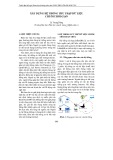
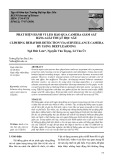
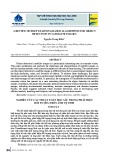

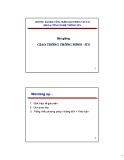






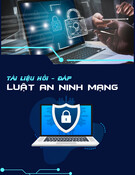




![Sổ tay Kỹ năng nhận diện & phòng chống lừa đảo trực tuyến [Mới nhất]](https://cdn.tailieu.vn/images/document/thumbnail/2025/20251017/kimphuong1001/135x160/8271760665726.jpg)
![Cẩm nang An toàn trực tuyến [Mới nhất]](https://cdn.tailieu.vn/images/document/thumbnail/2025/20251017/kimphuong1001/135x160/8031760666413.jpg)







